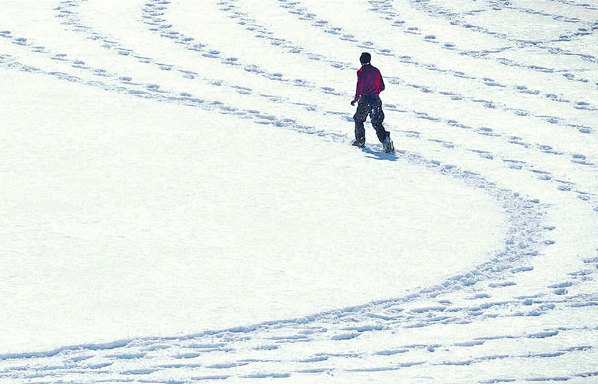A British artist brings his creative skill to the slopes of a Chinese ski resort. Xing Yi catches up with the former cartographer in Chongli.
Artist Simon Beck's tools are small and simple: a compass and a pair of snowshoes. His canvases? Snow-covered wintry landscapes.
His artworks are giant and sophisticated - complex geometric designs, each bigger than 100 square meters, drawn by his footprints.
Looking from above, a viewer will be amazed by the blend of intricacy with simplicity in those images, just like crop circles but created through hours of walking in the snow field.

The 57-year-old Briton has been doing those snowscapes every winter since he began in 2004 at a ski resort of Les Arcs in France. Since then, he has trodden on snows of many textures and locations, producing more than 250 "drawings" in different scales.
On March 8, Beck came to Chongli, Hebei province, some three hours' drive northwest from Beijing.
In two days, Beck had finished a mandala flower design on the slope of a local Fulong ski resort. This small town will host most of the ski events for the 2022 Winter Olympics.
"Usually I do a drawing on natural snow," says Beck. "But here is piste snow, which makes it harder to draw with footprints, ... I have to dig with a spade a little bit and that's why it took much longer."
A typical creation takes Beck about one day's work outdoors, after one or two hours of preparation indoors.
An Oxford University graduate in engineering, Beck worked as a cartographer before he became what he calls a "snow artist".
"All high-tech precision equipment is useless to me. I just need a compass to orient my way and some chocolate bars for energy," says Beck, who trained himself for years in orienteering and mapping.
Beck has enjoyed outdoor activities since his childhood. He recounts going to see snow in Scotland when he was 9, and appreciating the land art, or drawings on earth, such as the Cerne Abbas Giant and the Uffington White Horse, in southern England where he grew up.
He didn't start doing his own art, however, until he bought a small apartment high up in Les Arcs on the southeast side of the French Alps, when he started to learn skiing. By chance he drew a star for fun on a small snow-covered frozen lake outside his apartment building.
He was 44 that year.
In the past few years, Beck has produced about 30 images every winter, and in 2014, a decade after he drew the first star, he published a photo collections of his works, titled Snow Art.
Compared with traditional forms of art - murals, paintings and sculptures - which last for ages and crystallize the inspiration of artists, Beck's snow art seems momentary, reminding us of the fleeting nature of time.
"The record is eight weeks," Beck says of how long his works can last. "They gradually fade as footprints melt, and usually they are covered by more snow in one week."
"But it's good when they get covered, so you can do another drawing," Beck adds lightheartedly.
Winter is the busy season for Beck. Having finishing his artwork in Chongli for the Corona Sunset Festival last weekend, he's flying to the United States to be an artist in residence in a ski resort at Powder Mountain in the state of Utah.
Partly due to his engineering background and partly due to his previous cartography career, Beck's drawings are often mathematical fractals, such as patterns derived from a Mandelbrot set or Koch star. Simply put, they are combinations of a certain shape which reoccurs again and again, each time at a smaller scale.
"I have witnessed thousands of designs around the world over 30 years, and I have to say there are none that are more exquisite and impressive as yours," writes Colin Andrews, a crop circle researcher, congratulating Beck when his book was out.
In a report by The Guardian in 2014, Beck's work was described as an example of how "astonishing landscape and snow art illustrates the cold beauty of mathematics".
For Beck, the enjoyment of being outdoors has always been there. Before, when orienteering, he would examine the area and then draw the map. Now he does the reverse, as he put it in his book: "I start with a drawing, and make it on the ground, in the snow, in a limited amount of time."
Beck says he simply wants to make something beautiful in the mountains, and at the same time call people's attention to the environment.
"The drawing is part of the landscape and the landscape is part of the artwork," says Beck.
"The drawing wouldn't be as good had the landscape not been there."
In summer, when things slow down for Beck, he goes hiking in the mountains to keep himself in good shape, and looks after his aging parents.
Sometimes, he does drawings in sand on the beach in Somerset, England, about 40 minutes' drive from his home.
"It's another kind of race," writes Beck in his book, which includes two pieces of "sand art".
"This time against the tide."
Contact the writer at xingyi@chinadaily.com.cn
